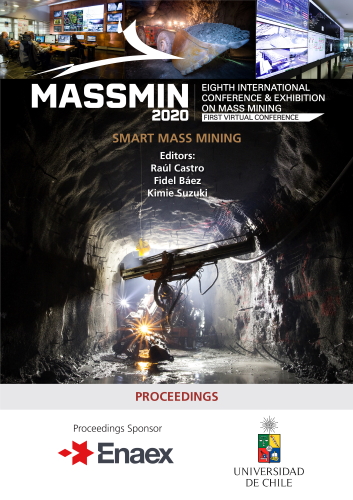Geotechnical hazard maps – A tool for ground support rehabilitation forecasting in active underground mines

|
Authors: Tasse, E; Griffiths, C; Bewick, R |
This paper is hosted with the kind permission of Lulea University of Technology, International Conference & Exhibition on Mass Mining, 2024.
DOI https://doi.org/10.36487/ACG_repo/2063_83
Cite As:
Tasse, E, Griffiths, C & Bewick, R 2020, 'Geotechnical hazard maps – A tool for ground support rehabilitation forecasting in active underground mines', in R Castro, F Báez & K Suzuki (eds), MassMin 2020: Proceedings of the Eighth International Conference & Exhibition on Mass Mining, University of Chile, Santiago, pp. 1134-1143, https://doi.org/10.36487/ACG_repo/2063_83
Abstract:
The combined effects of corrosion and mining-induced rock mass strain on ground support installed in underground mining environments can result in both safety concerns and economic risks. Degradation of the ground support can lead to potential rock falls, and the rehabilitation of ground support can result in unplanned costs and production schedule delays. Underground mining environments can expose ground support elements to a wide range of strain and corrosive conditions. While studies have been ongoing to understand the different corrosion mechanisms, and how these affect the life of the ground support, few efforts have been made to integrate corrosion rates (or life of ground support elements) and strain aspects into a forecasting tool, to provide for a more realistic estimate of quantity and frequency at which ground support would need to be replaced. This paper covers the development of a spatial and temporal geotechnical hazard map to support proactive replacement of ground support for an active underground mine, and details how: corrosion rates, and strain can be compiled to forecast the need of replacement of the installed ground support, and improve the reliability of critical production excavations. First, the relevant corrosion mechanisms impacting ground support elements are covered and a brief discussion of corrosion rate estimation is provided. The paper then discusses how excavation strain information should be integrated to forecast ground support lifespan and presents a methodology to produce a 3-dimentional map, that can be used as a tool for forecasting the ground support replacement due to corrosion and strain over the life of mine.
References:
Dorion, JF, Hadjigeorgiou, J & Ghali, E 2015, 'Quantifying losses in support capacity due to corrosion', Canadian Institute of Mining Journal, vol.6, no.3, pp.149-156.
Dorion, JF & Hadjigeorgiou, J 2014, 'Corrosion considerations in design and operation of rock support systems', Mining Technology, vol.123, no.2, pp. 59-68.
Dorion, JF, Hadjigeorgiou & J, Ghali, E 2009, 'Quantifying the rate of corrosion in selected underground mines', proceedings of the third CANUS Rock Mechanics Symposium, M. Diederichs and G Grasselli (eds), May 2009, Toronto, Canada.
Hassel, R, Villaescusa, E, Thompson, AG & Kinsella, B 2004, 'Corrosion assessment of ground support systems’, proceedings of the fifth International Symposium on Ground Support, Ground Support in Mining and Underground Construction, E
Villaescusa and Y Potvin (eds), 28‒30 September, Perth, Australia, Balkema, Rotterdam, pp. 529-544.
Hoek, E & Marinos, P 2000, 'Predicting tunnel squeezing problems in weak heterogeneous rock masses', Tunnels and Tunnelling International.
Hoek, E 1999, 'Support for very weak rock associated with faults and shear zones', Rocksupport and reinforcement practice in mining, E Villaescusa, CR Windsor and AG Thompson (eds), Rotterdam: Balkema, pp. 19-32.
Martin, CD, Kaiser, PK & Christiansson, R 2003, 'Stress, instability and design of underground excavations', International Journal of Rock Mechanics and Mining Sciences, vol. 40, pp. 1027-1047.
Preston, RP, Roy, J & Bewick, RP 2019, 'Rusty bolts: planning for corrosion of ground support in underground mines', proceedings of the ninth International Symposium on Ground Support in Mining and Underground Construction, J Hadjigeorgiou and M Hudyma (eds), Australian Centre for Geomechanics, Perth, pp. 423-436.
Roy, J, Preston, R & Bewick, RP 2016, 'Classification of aqueous corrosion in underground mines', Rock Mechanics and Rock Engineering, vol.49, 10.1007/s00603-016-0926-z.
World Bank Group 2020, Commodity Markets Outlook. April 2020.
© Copyright 2025, Australian Centre for Geomechanics (ACG), The University of Western Australia. All rights reserved.
View copyright/legal information
Please direct any queries or error reports to repository-acg@uwa.edu.au
View copyright/legal information
Please direct any queries or error reports to repository-acg@uwa.edu.au
